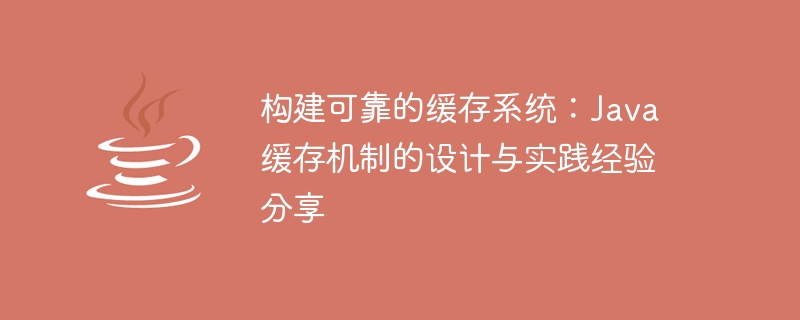
构建可靠的缓存系统:Java缓存机制的设计与实践经验分享
引言:
在大多数的应用程序中,数据缓存是提高系统性能的一种常见方法。通过缓存,可以减少对底层数据源的访问,从而显著缩短应用程序的响应时间。在Java中,我们可以采用多种方式实现缓存机制,本文将介绍一些常见的缓存设计模式和实践经验,并提供具体的代码示例。
一、缓存设计模式:
import java.util.HashMap;
import java.util.Map;
import java.util.concurrent.TimeUnit;
public class InMemoryCache<T> {
private final Map<String, CacheEntry<T>> cache;
private final long expirationTime;
private static class CacheEntry<T> {
private final T value;
private final long createTime;
CacheEntry(T value) {
this.value = value;
this.createTime = System.currentTimeMillis();
}
boolean isExpired(long expirationTime) {
return System.currentTimeMillis() - createTime > expirationTime;
}
}
public InMemoryCache(long expirationTime) {
this.cache = new HashMap<>();
this.expirationTime = expirationTime;
}
public void put(String key, T value) {
cache.put(key, new CacheEntry<>(value));
}
public T get(String key) {
CacheEntry<T> entry = cache.get(key);
if (entry != null && !entry.isExpired(expirationTime)) {
return entry.value;
} else {
cache.remove(key);
return null;
}
}
public static void main(String[] args) {
InMemoryCache<String> cache = new InMemoryCache<>(TimeUnit.MINUTES.toMillis(30));
cache.put("key1", "value1");
String value = cache.get("key1");
System.out.println(value);
}
}import java.io.*;
import java.util.HashMap;
import java.util.Map;
public class DiskCache<T> {
private final Map<String, File> cache;
public DiskCache() {
this.cache = new HashMap<>();
}
public void put(String key, T value) {
try {
File file = new File("cache/" + key + ".bin");
ObjectOutputStream outputStream = new ObjectOutputStream(new FileOutputStream(file));
outputStream.writeObject(value);
outputStream.close();
cache.put(key, file);
} catch (IOException e) {
e.printStackTrace();
}
}
public T get(String key) {
File file = cache.get(key);
if (file != null && file.exists()) {
try {
ObjectInputStream inputStream = new ObjectInputStream(new FileInputStream(file));
T value = (T) inputStream.readObject();
inputStream.close();
return value;
} catch (IOException | ClassNotFoundException e) {
e.printStackTrace();
}
}
cache.remove(key);
return null;
}
public static void main(String[] args) {
DiskCache<String> cache = new DiskCache<>();
cache.put("key1", "value1");
String value = cache.get("key1");
System.out.println(value);
}
}二、缓存实践经验:
立即学习“Java免费学习笔记(深入)”;
三、结论:
通过合理设计和使用缓存机制,可以显著提高应用程序的性能和响应速度。在构建可靠缓存系统时,选择合适的缓存策略,定期进行缓存清理和过期处理,并考虑分布式缓存的一致性。本文提供了基于内存和磁盘的缓存设计模式的具体代码示例,希望对读者构建可靠的缓存系统有所帮助。
参考文献:
以上就是构建稳定可靠的缓存系统:Java缓存机制的设计与实施经验分享的详细内容,更多请关注php中文网其它相关文章!

java怎么学习?java怎么入门?java在哪学?java怎么学才快?不用担心,这里为大家提供了java速学教程(入门到精通),有需要的小伙伴保存下载就能学习啦!




Copyright 2014-2025 https://www.php.cn/ All Rights Reserved | php.cn | 湘ICP备2023035733号